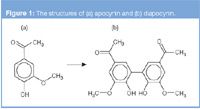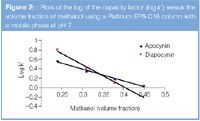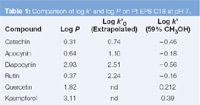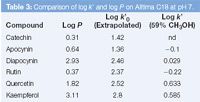An Evaluation of the Determination of the Lipophility of Apocynin and Diapocynin using HPLC
LCGC Europe
This study evaluates the use of HPLC to estimate the log P (the octanol–water partition coefficient) of two compounds, apocynin and diapocynin. The paper will discuss the effects of an unexpected reversal of retention that occurred when these compounds were chromatographed with various amounts of methanol–water mobile phases.
Log P (the log of the octanol–water partition coefficient) is used to determine the bioavailability of a compound; the ability to pass through a cell membrane, permeate the skin, or partition between soil and water and persist in the environment.1 Alternately, reversed-phase high performance liquid chromatography (RP–HPLC) can be used in place of the octanol–water partition by comparing the capacity factors, also known as k' values, of a series of compounds on a C18 column with a mobile phase consisting of a mixture of methanol and water. A solute's hydrophobicity affects its retention on C18 columns, compounds with a larger k' are considered to be more hydrophobic than those with lower k' values.2–4
This study evaluates the use of HPLC to estimate the log P of two compounds, apocynin, also known as acetovallinone, and diapocynin. The standard EPA shake flask method was used to determine that the log P values of apocynin and diapocynin were 1.01 ± 0.06 and 1.82 ± 0.08 (n = 5), respectively.3
When conducting the HPLC studies, there was an unexpected reversal of retention when these compounds were chromatographed with increasing concentrations of methanol on two different C18 columns. This retention change adversely affected the log P prediction, preventing the use of HPLC for determining an accurate log P. It is concluded that HPLC can give misleading information about the lipophilicities of apocynin and diapocynin. However, these two compounds are unusual. HPLC should still be considered a valid method of predicting log P values.
Apocynin has generated much interest in treating or preventing diseases of inflammation, including arthritis, heart disease, cancer, stroke and Alzheimer's disease.5–11 Apocynin (4-hydroxy-3-methoxyacetophenone) was identified during activity-guided isolation of immunomodulatory constituents from Picrorhiza kurroa, a native plant grown in the mountains of India, Nepal, Tibet and Pakistan.12 This compound specifically blocks the activity of nicotinamide adenine dinucleotide phosphate (NADPH) oxidase, a cell membrane enzyme known to protect against reactive oxygen species, or ROS.5 Also, it has been suggested that diapocynin a metabolite of apocynin may be more active than apocynin, so it might be useful to test the effects of diapocynin on test animals or cells grown in culture.13 To facilitate these cell or animal studies, the partition coefficient (Log P) for each compound was determined using RP–HPLC.
Although apocynin is readily available commercially, diapocynin had to be synthesized so that it could be studied in vitro or in vivo. The structures of apocynin and diapocynin are illustrated in Figure 1.

Figure 1: The structures of (a) apocynin and (b) diapocynin.
Apocynin is converted to diapocynin by an oxidation–reduction reaction, requiring the in situ generation of sulphate radicals, which remove one hydrogen from each molecule of apocynin, producing diapocynin.
Materials
Apocynin (acetovallinone, Sigma-Aldrich, St Louis, Missouri, USA) was recrystallized from water and dried in a desiccator before use. Diapocynin was synthesized by dissolving about 2 g of apocynin in 200 mL of deionized water with stirring and heating until the solution was boiling gently. To this was added 0.15 g of ferrous sulphate heptahydrate and 1.6 g of sodium persulphate. A brown precipitate formed. After 5 min, the solution was cooled and filtered. The precipitate was dissolved in 3 N NH4OH and then reprecipitated by adding 6 N HCl. The precipitate was filtered and washed three times with 100 mL of boiling water, then washed three times with 100 mL of boiling methanol. The diapocynin was at least 99% pure, based on analysis by LC–MS.14 The procedure is similar to that used to synthesize a similar compound, dehydrodivanillin.15 All other chemicals were from Sigma-Aldrich (St Louis, Missouri, USA).

Figure 2: : Plots of the log of the capacity factor (log k') versus the volume fraction of methanol using a Platinum EPS C18 column with a mobile phase at pH 7.
HPLC Analysis
RP–HPLC was done using a Shimadzu LC-10 AS HPLC (Shimadzu, Kyoto, Japan), equipped with an LC-10 AV (Shimadzu) ultraviolet visible (UV/vis) detector, set to monitor 215 and 276 nm. Three different C18 columns from Grace Davison Discovery Sciences (Deerfield, Illinois, USA) were used: an Alltech Platinum EPS (extended polar selectivity) (Alltech, Deerfield, Illinois, USA) with 100 Å pore size; an Ace (MacMold Analytical Inc., Chadds Ford, Pennsylvania, USA); and an Alltima (Alltech). Both were 4.6 × 150 mm and had particles with a 5 μm diameter. Isocratic mobile phases were used. Different mixtures of methanol and water were used, but there was always 0.31 g/L ammonium acetate, either at pH 7.0, or pH 4.5 (adjusted with acetic acid). The flow-rate was 1.0 mL/min and the injection volume was 20 μL. The void volume was measured by injecting an aqueous solution of sodium nitrate.
Measuring log P
Recrystallized apocynin and diapocynin, each at least 99% pure,14,15 were used to measure the log P by the shake flask method,1 in which the water was acidified with HCl (to pH 2.0), to ensure that the diapocynin was not ionized. As specified in the cited method, the n-octanol was presaturated with water and the water was presaturated with n-octanol. The apocynin and diapocynin concentrations in the aqueous phase were determined using the HPLC method with UV detection at 276 nm. The concentrations of apocynin and diapocynin in the water-saturated n-octanol phase were determined by extracting the octanol with 0.05 N NaOH, followed by dilution with deionized water and analysis by HPLC with detection.

Table 1: Comparison of log k' and log P on Pt EPS C18 at pH 7.
Results and Discussion
It was found that apocynin and diapocynin concentrations could be determined by HPLC with UV detection using the Platinum EPS C18 column (Alltech). This column has a relatively high level of silica exposure and is best used with compounds having two or more functional groups.16 Linear calibration curves (r2 = 0.9999) were obtained for apocynin and diapocynin at concentrations of 0.16–30 μg/mL.

Figure 3: Plots of the log of the capacity factor (log k') versus the volume fraction of methanol, using an Alltech C18 column with a mobile phase at pH 7.
The log P values for apocynin and diapocynin were found to be 1.01 ± 0.06 and 1.82 ± 0.08 (n = 5), respectively. The standard EPA shake flask method was used to determine log P. Although the precision of the log P values was good for this method, it is not near as good as the precision of the HPLC method, in which retention times and capacity factors can be repeatedly measured with a relative standard deviation which is much lower.
The log P values would indicate that diapocynin should be retained on a C18 column longer and have a higher k' than apocynin. This was true when the volume fraction of methanol was 30% or less and the pH was 7, but was not true at higher concentrations of methanol in the mobile phase, when either the Platinum-EPS or Alltima (Alltech) column were used. Other workers also found that diapocynin eluted before apocynin when a sufficiently strong mobile phase was used.17 Plots of the log k' versus the volume fraction of methanol (at pH 7) are shown in Figures 2–3. A comparison of the log k' and log P values to those found for catechin, rutin, quercetin and kaempferol is in Tables 1–2. Different results were obtained when one compares log k' at 59% methanol to log k' extrapolated to zero methanol (log k'0).
The data show a poor correlation between log P and log k' when apocynin and diapocynin are included. However, it was previously demonstrated that good correlations were obtained for catechin and many other polyphenols, when apocynin and diapocynin were not included.18 Thus, apocynin and diapocynin are exceptions to the general rule that HPLC can be used to predict the log P of many other compounds.

Table 2: Comparison of log k' and log P on Pt EPS C18 at pH 4.5.
Plots of the log k' versus the volume fraction of methanol at pH 4.5 are shown in Figures 4–5. Apocynin and diapocynin do not show a reversal in retention at this pH, but their log k' values are much closer to each other than they should be because they have such different log P values. A comparison of the log k' and log P values to those found for catechin, rutin, quercetin and kaempferol is in Tables 3–4. Different results were obtained when one compares log k' at 59% methanol to log k' extrapolated to zero methanol (log k'0). Again, the data show a poor correlation between log P and log k'.

Figure 4: Plots of the log of the capacity factor (log k') versus the volume fraction of methanol, using an Ace C18 column with mobile phase at pH 7.
The Alltima (Alltech) column does not have exposed silica, unlike the Platinum EPS column (Alltech). It has been observed that the exposed silica can affect the retention order of some compounds on the Platinum EPS (Alltech), so columns with little or no exposed silica are usually used when predicting log P for other compounds.2,3
For compounds to be considered similar to each other, plots of log k' vs volume fraction of methanol should produce nearly the same slope.2 As shown in Figures 2–3, this is not true for apocynin and diapocynin. The slopes were higher for diapocynin. The slopes were –2.8 and –5.1, for apocynin and diapocynin, respectively, when the Platinum–EPS (Alltech) was used, –6.6 and –7.9 with the Alltech C18 (Alltech), and –2.5 and –4.7 with the Ace (MacMold Analytical Inc.) column. The slopes were related to the number of water molecules that are removed from a solute when it is retained onto a C18 column and the number of phenolic hydroxyls on the analyte.2 Because diapocynin has two phenolic hydroxyls compared with one for apocynin, it might be expected to have a higher slope.

Table 3: Comparison of log k' and log P on Alltima C18 at pH 7.
The different slopes also mean that the retention order of apocynin and diapocynin depended on the amount of methanol in the mobile phase. Similar results were reported for the retention of adenine, adenosine and adenosine 3',5'-monophosphate, which were not considered to be similar to each other.2 However, it may be surprising that apocynin and diapocynin are not similar compounds when evaluating their log P by HPLC because several other compounds (flavonoids) containing one, two or three phenolic hydroxyls were considered to be similar in a previous study that estimated the log P by HPLC.18

Table 4: Comparison of log k' and log P on Alltima C18 at pH 4.5.
Thus, it may be difficult to predict whether two compounds are similar enough to estimate their log P values from a single measurement of retention time with only one mobile phase. Often it is better to use the log k' extrapolated to zero methanol, or log k'0, to predict if compounds are similar when evaluating their log P values. If the log P is going to be used to predict the bioavailability of a compound, it is also important to remember that the pH of blood is close to 7.4. The shake flask method specifies measuring the log P at pH 2, to ensure that only the unionized phenols are present. However, the pKa of both apocynin and diapocynin is 7.4,14 so both compounds would be partly ionized and the apparent log P at pH 7.4 might be a better indicator of the oral bioavailability of diapocynin (or apocynin). The pH of the stomach is about 1.6, so both apocynin and diapocynin would be uncharged and would be expected to be more bioavailable if introduced directly into the stomach by gavage.
Because apocynin and diapocynin might be able to prevent some diseases, it is important that these compounds can move across the cell membrane. If the log P is used to estimate the comparative abilities of apocynin and diapocynin to move across the cell membrane, one might conclude that diapocynin would be more bioavailable than apocynin. If the solubility in octanol is used, though, diapocynin would be expected to be less bioavailable because it is less soluble in octanol than apocynin. The only reason why diapocynin has the higher log P is because diapocynin is much less soluble in water, so the ratio of its solubility in octanol to its solubility in water is higher.
Another important factor in bioavailability is the possibility of metabolism. In recent studies, it was shown that when apocynin was given to gerbils by intraperitoneal injection, the apocynin was metabolized to a glycoconjugate in the blood, and it was not converted to diapocynin.19 Thus, even though HPLC analysis has been used extensively to predict log P and bioavailability of many compounds, sometimes it is better to do the HPLC analysis at several different concentrations of methanol in the mobile phase and use log k'0. One should consider whether a higher log k'0 is actually a result of an increased solubility in octanol, or a very large decrease in water solubility, causing an increase in the ratio of solubilities in octanol and water. It is also important to consider the pKa of a compound and the effect that pH has on the apparent log P. Finally, metabolic changes can affect bioavailability, especially if sugars are added to form water-soluble glycoconjugates. Therefore, actual measurements of bioavailability should be completed. This work should not be taken as reflecting FDA policy or regulations.
Acknowledgment
We wish to acknowledge Ann Adams for her careful review of this paper and her helpful suggestions.
Robert Smith is an assistant professor at Park University and a Science Advisor for the USA FDA. He teaches chemistry and does research on foods and drugs.
Ron Luchtefeld is a chemist with the FDA specializing in the development of analytical methods for determining pesticide residues in foods.
References
1. J. Sangster, Octanol Water Partition Coefficients: Fundamentals and Physical Chemistry (John Wiley, New York, 1997), pp. 12–13.
2. T. Baumann, J. Chromatogr., 373(1), 191–225 (1986).
3. United States Environmental Protection Agency, OPPTS 830.7570 Partition Coefficient (n-Octanol–Water), Estimation by Liquid Chromatography. (1996).
4. K. Valko, LC•GC North America, 25(3), 284–291 (2007)
5. Q. Wang et al., Brain Res., 1090(1), 182–189 (2006).
6. Z. Yang et al., Am. J. Physiol. Regul. Comp. Physiol., 290(1), 96–104 (2006).
7. Y. Hashimoto et al., J. Pharmacol. Exp. Therap., 300(3), 736–745 (2002).
8. J.M. Dodd-o et al., AJP-Heart., 287(2), 927–936 (2004).
9. F.P.J.G Lafeber et al., Rheumetol., 38(11), 1088–1093 (1999).
10. R.F. Klees et al., J. Biomed. Biotechnol., 2006(1), 1–10 (2006).
11. J. Stolk et al., Am. J. Respir., Cell. Mol. Biol., 11(1), 95–102 (1994).
12. Picrorhiza kurroa, 2001 Picrorhiza kurroa. Monograph, Altern. Med., Rev. 6(1) 319–321 (2001).
13. S. Antoniotti et al., Org. Lett., 6(12), 1975–1978 (2004).
14. R. Luchtefeld et al., Dose formulation and analysis of diapocynin, J. Agric. Food Chem., in print.
15. K. Elbs and H. Lerch, H. J. Prakt. Chem., 93(1), 1–6 (1916).
16. Grace Davison Discovery Sciences, Alltech Platinum HPLC Columns,
http://www.alltechweb.com/productinfo/platinum/platinum.asp (2007).
17. V.F. Ximenes et al., Arch. Biochem. Biophys., 457(1), 134–141 (2007).
18. J.A. Rothwell et al., J. Agric. Food Chem., 53(1), 4355–4360 (2005).
19. Q. Wang et al., Bioavailability of apocynin through its conversion to glycoconjugate but not to diapocynin, Phytomed., in print.

Polysorbate Quantification and Degradation Analysis via LC and Charged Aerosol Detection
April 9th 2025Scientists from ThermoFisher Scientific published a review article in the Journal of Chromatography A that provided an overview of HPLC analysis using charged aerosol detection can help with polysorbate quantification.
Removing Double-Stranded RNA Impurities Using Chromatography
April 8th 2025Researchers from Agency for Science, Technology and Research in Singapore recently published a review article exploring how chromatography can be used to remove double-stranded RNA impurities during mRNA therapeutics production.














